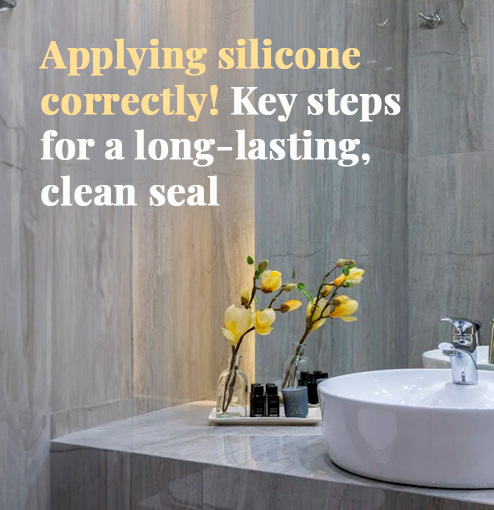
Bathroom silicone is an essential material for keeping your bathroom in top condition. Its main function is to seal joints and prevent water from seeping into areas where moisture issues can occur. It also helps prevent mold and mildew growth. In this blog, I’ll cover the different types of silicone, how to apply it, how much it costs, and what colors are available.
Types of Bathroom Silicone
There are several types of silicone, each designed for different applications and conditions. The most common ones are:
1. Acetic Silicone
This is one of the most popular types for bathrooms. It has high adhesion to smooth surfaces such as glass, ceramic, or tiles. However, it can release vapors during curing, so it should be applied in a well-ventilated area. It has antifungal properties, making it ideal for humid areas.
Advantages:
- Resistant to mold and mildew.
- Dries quickly.
Disadvantages:
- Not suitable for metal surfaces, as it can cause corrosion.
2. Neutral Silicone
Unlike acetic silicone, neutral silicone does not release acidic vapors during curing. This makes it a more versatile option, as it can be used on a wider range of materials such as plastic, wood, and metals. It also has antifungal properties and is ideal for sealing joints in high-humidity areas.
Advantages:
- Non-corrosive.
- Suitable for various materials.
Disadvantages:
- Takes a bit longer to dry than acetic silicone.
3. Anti-Mold Silicone
This type of silicone has a specific formulation that includes additives to prevent mold growth. It is ideal for areas with a lot of water exposure, such as showers, bathtubs, and sinks.
Advantages:
- Long-lasting in humid areas.
- Maximum protection against mold.
Disadvantages:
- Can be slightly more expensive than standard silicones.

How to Apply Bathroom Silicone
Applying silicone is not complicated, but it’s important to follow some key steps to achieve a durable and neat seal.
- Preparation:
- Clean the area thoroughly: Ensure the surface is clean, dry, and free from grease or dust. If there is old silicone, remove it completely with a spatula or special tool.
- Use painter’s tape: Place tape on both sides of the joint to ensure precise application and avoid smudging on the surfaces.
- Application:
- Cut the silicone tube at an angle, depending on the thickness of the line you need to apply.
- Use a silicone applicator gun to push the material evenly along the joint. Make sure to apply enough silicone to cover the entire space.
- Smoothing:
- Use a moistened finger or a special tool to smooth the silicone, gently pressing it to ensure it adheres well to the surfaces.
- Remove the painter’s tape before the silicone dries for a clean finish.
- Drying:
- Let the silicone dry according to the manufacturer’s instructions, typically between 24 and 48 hours before it comes into contact with water.
How Much Does Bathroom Silicone Cost?
The price of bathroom silicone varies depending on the type, brand, and specific properties (such as mold resistance). Approximate prices are:
- Standard silicone: Between €3 and €5 per 280 ml cartridge.
- Anti-mold silicone: Between €5 and €8 per cartridge.
- Neutral silicone: Between €4 and €7 per cartridge.
You can find packs of several cartridges at more affordable prices, and some high-end types of silicone can cost up to €10 per unit.

Available Colors
Traditionally, bathroom silicone has been available in white and clear, but nowadays, a wider range of colors is available to better match your bathroom’s design. Some of the most common colors include:
- White: Ideal for classic-style bathrooms and for pairing with light-colored tiles.
- Clear: Perfect when you want the seal to be less visible.
- Gray: A neutral color that works well in modern or minimalist bathrooms.
- Black: For bathrooms with a more industrial or contemporary style.
- Beige or ivory: Used to blend with warm tones or natural stone.
It’s important to choose a color that blends well with the rest of the bathroom elements for a harmonious result.

